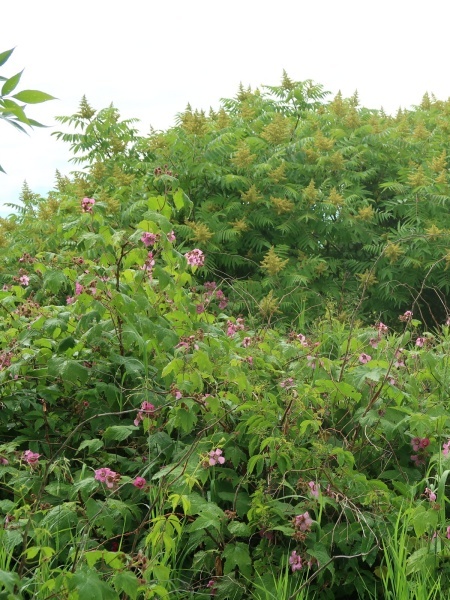
Source: OWSL
Rubus odoratus
Purple-flowering Raspberry
Ronce odorante
Synonyms
eastern maple-leaved raspberry
flowering raspberry
Calottes
framboisier sauvage
Seeds in stock
Available at table Vines, Shrubs, Trees
Available at table Vines, Shrubs, Trees
We currently accept seeds for this plant
Bloom Colour: Pink
Bloom Period: Jun - Aug
Max Height: 6.0 feet
Max Width: 12.0 feet (spreads by rhizome)
Light Condition:
 More than 6 hours of direct sun a day
More than 6 hours of direct sun a day
 More than 2 or 3 hours but less than 6 hours of direct sun a day
Soil conditions:
More than 2 or 3 hours but less than 6 hours of direct sun a day
Soil conditions:
 Tolerates medium soil condition
Tolerates medium soil condition
 More than 6 hours of direct sun a day
More than 6 hours of direct sun a day
 More than 2 or 3 hours but less than 6 hours of direct sun a day
More than 2 or 3 hours but less than 6 hours of direct sun a day
 Tolerates medium soil condition
Tolerates medium soil condition
Lifespan:
Perennial
plants that will that come back year after year
Gardener Experience:
 Self-seeding
Self-seeding
 Self-seeding
Self-seeding
Landscape Uses:
 Suitable for rock gardens
Suitable for rock gardens
 Suitable for rain gardens
Suitable for rain gardens
 Suitable for shoreline rehabilitation
Suitable for shoreline rehabilitation
 Suitable for school gardens
Suitable for school gardens
 Can be used as a hedge
Can be used as a hedge
 Suitable for rock gardens
Suitable for rock gardens
 Suitable for rain gardens
Suitable for rain gardens
 Suitable for shoreline rehabilitation
Suitable for shoreline rehabilitation
 Suitable for school gardens
Suitable for school gardens
 Can be used as a hedge
Can be used as a hedge
Ecological Benefits:
 Supports birds
Supports birds
 Supports pollinators
Supports pollinators
 Keystone species
Keystone species
 Supports birds
Supports birds
 Supports pollinators
Supports pollinators
 Keystone species
Keystone species
Tolerates:
 Tolerates limestone conditions
Tolerates limestone conditions
 Tolerates juglone conditions
Tolerates juglone conditions
 Tolerates transplantation
Tolerates transplantation
 Tolerates limestone conditions
Tolerates limestone conditions
 Tolerates juglone conditions
Tolerates juglone conditions
 Tolerates transplantation
Tolerates transplantation
Special Features and Considerations:
Plant Location
Native to Ottawa region: Yes
Distribution according to VASCAN

Ephemeral
Native
Introduced
Excluded
Extirpated
Doubtful
Absent
Thrives in Ecozones
- Atlantic Maritime
- Boreal Shield
- Mixed Wood Plains
Ecological Benefits
Butterflies Supported by Rubus odoratus
- Automeris io (Io moth)
Specialized Bees Supported by Rubus odoratus
No bee data available for this plant.
Plants that grow in similar conditions, that bloom at the same time.
Complementary Plants
- No complementary plants found.
Substitute For Non-Native Plants
- Rosa (Non-native Roses)
- Rosa multiflora (Multiflora Rose)
Sowing Information
Download Seed Envelope Labels (PDF)
- Sowing depth: Sow just below surface
- Sow by January
- Stratification duration: 90 days
- Self-seeding
- Notes: Soak in hot water for 24h.
Harvesting and Seed Sharing
- Harvest start month: July
- Harvesting indicator:
- Berries are ripen and easily fall off or have fallen off
- Harvesting:
- Squeeze berries to extract seeds, wash with soapy water, rinse throroughly
- Seed viability test:
- No test needed before donating
- Packaging measure: A dozen (12) seeds (eyeball)
- Seed storage:
- Air dry in paper bag or open container, for a few days until crisp
- Shake seeds to move them once in a while to prevent molding
- Cultivar: No, you can donate without knowing the source as there are only straight species
- No harvesting video available at this time.
Toxicity Notes
Not known to be toxic to mammals if ingested.


 Canadensis
Canadensis
